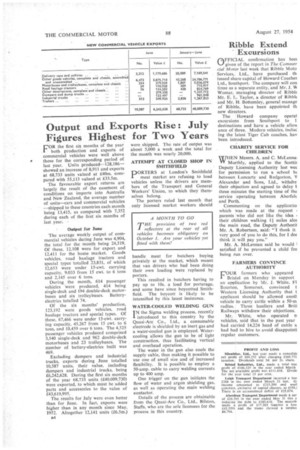Output and Exports Rise : July Figures Highest for Two Years
Page 38

If you've noticed an error in this article please click here to report it so we can fix it.
FOR the first six months of the year both production and exports of commercial vehicles were well above • those for the corresponding period of last year. Units produced-128,186showed an increase of 8,911 and exports at 68,733 units valued at £40m. compared with 55,113 valued at £33.5m.
The favourable export returns are largely the result of the easement of conditions on imports into Australia and New Zealand, the average number of units-cars and commercial vehicles -shipped to these countries each month being 13,415, as compared with 7,352 during each of the first six months of last year.
Output for lane
The average weekly output of commercial vehicles during June was 4,904, the total for the month being 24,519. Of these, 12,108 were for export. and 12,411 for the home market. Goods vehicles, road haulage tractors and special types -totalled 23,831, of which 12,653 were under 15-cwt. carrying capacity, 9,033 from 15 cwt. to 6 tons and 2,145 over 6 tons.
During the month, 614 passenger vehicles were produced, 414 being single-deck and 194 double-deck motor
buses and six trolleybuses. Batteryelectrics totalled 74.
Of the six months' production, 123,192 were goods vehicles, road haulage tractors and special types. Of these, 67,466 were under 15-cwt. carrying capacity, 45.267 from 15 cwt. to 6 tons, and 10,459 over 6 tons. The 4,525 passenger vehicles produced comprised 3,540 single-deck and 962 double-deck motorbuses and 23 trolleybuses. The number of battery-electrics built was 469.
Excluding dumpers and industrial trucks, exports during June totalled 10,587 units, their value, including dumpers and industrial trucks, being £6,242,628. During the first six months of the year 68,733 units (£40,009,730) were exported, to which must be added parts and accessories to the value of £43,619,995.
The results for July were even better than for June. In fact, exports were higher than in any month since May, 1952. Altogether 12,141 units (£6.5m.) B4 were shipped. The rate of output was about 5,000 a week and the total for the month was nearly 20,000.
ATTEMPT AT CLOSED SHOP IN SMITHFIELD
PORTERS at London's Smithfield meat market are refusing to load vehicles unless the drivers are members of the Transport and General Workers' Union, to which they themselves belong.
The porters ruled last month that only licensed market workers should handle meat for butchers buying privately at the market, which meant that van drivers who had been doing their own loading were replaced by porters.
This resulted in butchers having to pay up to 10s. a load for porterage, and some have since boycotted Smithfield. The boycott is likely to be intensified by this latest insistence.
WATER-COOLED WELDING GUN IN the Sigma welding process, recently .1 introduced to this country by the Quasi-Arc Co., Ltd., a consumable electrode is shielded by an inert gas and a water-cooled gun is employed. Watercooling allows the gun to be of light construction, thus facilitating vertical and overhead operation.
The water in the gun also cools the supply cable, thus making it possible to use one of small size and of increased flexibility. It is possible to employ a 50-amp. cable to carry welding currents up to 400 amp.
One trigger on the gun initiates the flow of water and argon shielding gas, as well as operating the main welding contactor.
Details of the process are obtainable from the Quasi-Arc Co., Ltd., Bilston, Staffs, who are the sole licensees for the process in this country.




























































































